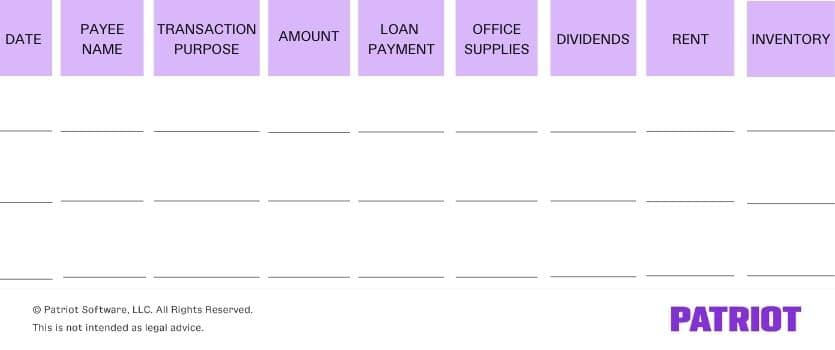Does your small business work with cash? More than likely, the answer is yes. And when you have cash expenses, you should record them in a cash disbursement journal.
Creating journal entries for small business transactions should be like second nature. But with so many types of entry types, it can be hard to keep up. Read on to get a closer look at recording cash disbursements in your books.
What is cash disbursement?
A cash disbursement is a payment that a business makes with cash or a cash equivalent. Cash disbursement payments show how much money is flowing out of a business. You can compare your company’s disbursements to the money coming into your business to determine whether you have a positive or negative cash flow.
So, what is considered a cash payment? Is it just cash? Turns out, no. Cash payments include:
- Cash
- Check
- EFT payment (electronic funds transfer)
Purchasing inventory or office supplies, paying out dividends, or making business loan payments with cash or cash equivalents are examples of disbursements.
Your cash disbursement journal can provide an up-to-date snapshot of these cash payments during a specific time period (e.g., quarter or year). Missing a journal entry can throw off your running balance and cause you to misread your financial health.
Keep in mind that cash disbursements are just one half of the coin. You must also record cash receipts when you collect money from your customers. Record incoming cash payments in a separate cash receipts journal.
Creating your cash disbursement journal
Your cash disbursement journal is a record of all of your business’s outflowing cash. By itemizing all cash payments, this journal helps businesses organize their outgoing cash records.
Before creating a disbursement journal, you must know:
- When to create them
- What information to include
- How they should look
- Where the journal entries go
Learn more about creating your cash disbursement journal below.
When do you create a journal?
Create and update a cash disbursement journal whenever you purchase something with cash or a cash equivalent.
Let’s say you write a $320 check for a new printer. You would create a new line in your journal for the purchase.
What information should you include?
When it comes to recording cash disbursements, be as specific as possible. Don’t just include the amount of money you spent on the transaction.
Cash disbursement journals should include:
- Date
- Payee name
- Amount debited or credited
- Accounts involved (e.g., payment method)
- Purpose of the transaction
Depending on the payment method, you may also want to record additional information, like the check number.
When recording your disbursement journal, pull information from purchase receipts, checkbook stubs, or invoices.
How does a cash disbursement journal look?
Because you’re spending cash or cash equivalents, you will need to decrease the cash or cash equivalents account. You can do this by crediting it. You must also debit the corresponding expense account.
Here’s an example of how your journal entries may look.
| Date | Account | Notes | Debit | Credit |
|---|---|---|---|---|
| XX/XX/XXXX | Expense | Expenses from Company ABC | X | |
| Cash | X |
After creating journal entries, add them to your cash disbursement journal. Your cash disbursement journal should look like this:

Where does the cash disbursement journal go?
After creating a cash disbursement journal, your work isn’t over. Use the information from your cash disbursement journal to update your other records.
Input the information from your disbursement journal into your small business general ledger. Transfer debit and credit amounts, the date, and a description of the transaction to your ledger.
After posting the information to your ledger, calculate new balances for each account.
In addition to transferring cash disbursement journal information to your general ledger, you can also use it for reconciling bank statements. That way, you can ensure your cash disbursement journal entries match your bank statements.
Cash disbursement journal example
Let’s say that you make the following cash or cash equivalent payments:
- Loan payment of $250
- Inventory purchase of $500
- Dividend payment of $2,500
First, create journal entries that credit your cash accounts and debit the corresponding accounts.
| Date | Account | Notes | Debit | Credit |
|---|---|---|---|---|
| XX/XX/XXXX | Loan Accounts Payable | Loan #1 payment to Lender ABC | 250 | |
| Cash | 250 |
| Date | Account | Notes | Debit | Credit |
|---|---|---|---|---|
| XX/XX/XXXX | Inventory | Wood and glue purchased from Company XYZ | 500 | |
| Cash | 500 |
| Date | Account | Notes | Debit | Credit |
|---|---|---|---|---|
| XX/XX/XXXX | Dividends Accounts Payable | Dividend payments made to shareholders | 2,500 | |
| Cash | 2,500 |
Now, update your cash disbursement journal so it looks as follows:

Tired of manually handling your books? Patriot’s online accounting software can streamline the way you track incoming and outgoing money. Start your free trial today!
This is not intended as legal advice; for more information, please click here.
